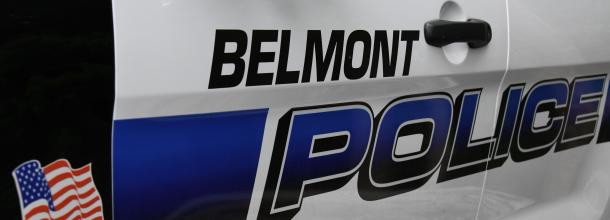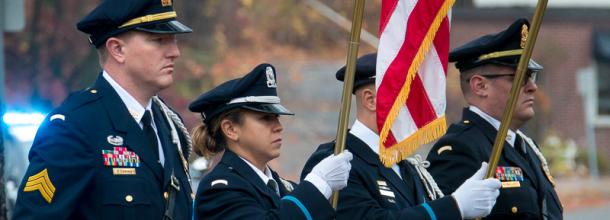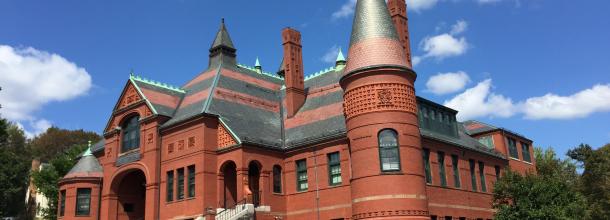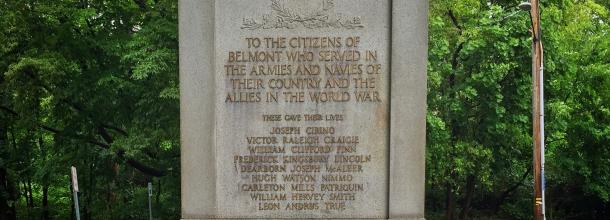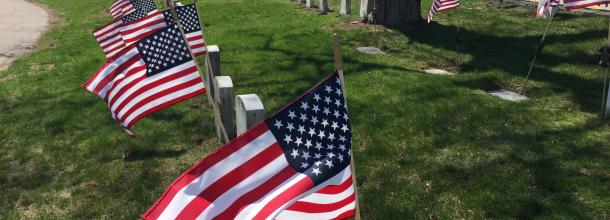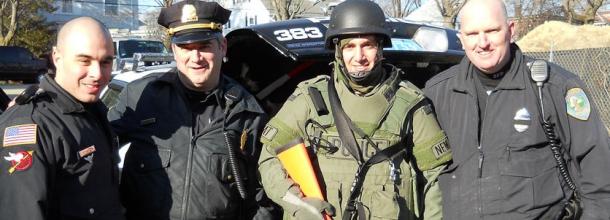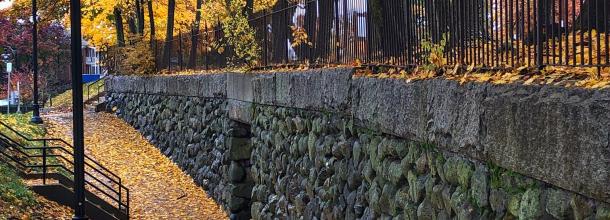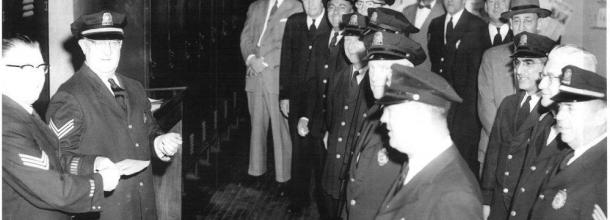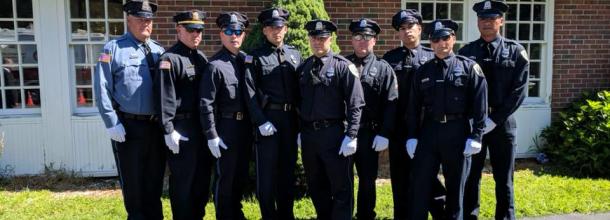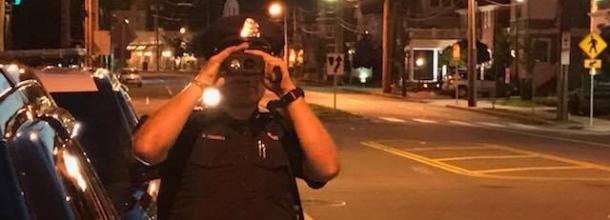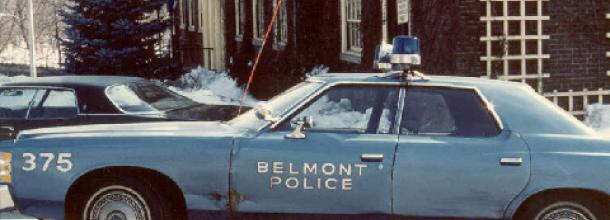Department History
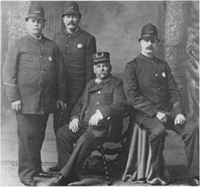
Belmont Police Department, circa 1896
John Argy, David McCabe, Chief Jerry Ryan, Frank chant
The Belmont Police Department, like the departments of other cities and towns, had a very small beginning. In the 1870's, Belmont was gaining a reputation among hobos as a "Tramp's Paradise." The residents were generous. They provided food for hundreds of tramps coming and going from Boston and it soon got to be quite a problem.
So in 1877, at a cost of $5,400, the town built a 12 room "Tramp House and Stable" with five jail cells in the basement on six acres of land on Concord Avenue where Stewart Terrace is today. David Chenery, Jr. was named Roadmaster and Constable. Thus, in effect, he became the first Superintendent of Highways and Police Chief, and he moved into the new building which can be considered the first police station and jail.
Over the years that building got a lot of use. Tramps were given lodging there as they passed through town. In return, they were obligated to work for two to three hours the next morning in the town gravel pit at the rear of the property, given crackers and cheese, and sent on their way.
At that time, the Town had four constables who made up the police force including Frank D. Chant who in 1885 was named Police Chief. The town report of that year for the first time listed a police chief as an actual title so Mr. Chant was therefore the first "official" chief of police. Although, David Chenery, Jr. might also lay claim to that honor.
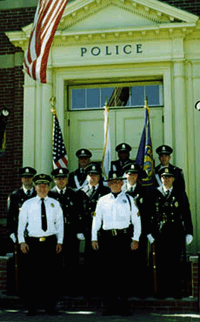
Belmont Police Honor Guard, 1997
In his first report, Chief Chant listed a total of 11 arrests and that 1,304 tramps were put up during the year. Perhaps being dissatisfied with the Tramp House arrangement, he recommended in 1887 a great need for a lock-up at the town hall. His 1888 report listed only seven arrests for the year with five of them for drunkenness. That year, he also worked for the highway department where his duties must have been more arduous as for that year he was paid $89.71 as Police Chief and $791.11 from the highway budget. He ended his 1888 report with the following: "Owing to the large number of homes broken into in this town and adjoining towns, I would recommend the need of having more officers for night duty. When houses are broken into, if the occupants would notify the police at once, it would be a great help to them in detecting the thief and recovering the stolen goods."
In 1891, Chief Chant, along with being Police Chief, was appointed Superintendent of Streets and over the next few years added Field Driver, Commissioner of Burial Grounds and Tree Warden to his duties. In his 1894 report, he listed 22 arrests and 6,039 tramps "furnished with lodging." His salary had risen to $200 a year. The 1900 report of the Board of Selectmen offers the following: "With the advent of the electric road, (the Waverley street car line) come almost daily within our boundaries a large number of promiscuous strangers, not to mention the throngs that in good weather, especially on Sundays and holidays, are constantly passing through the town on bicycles; then again the modern craze of golf, the playing of which on Sunday is objectionable to some, all contribute with other factors, to form an aggregation, or condition not previously, we think, contemplated in our police provision.
"To the credit of the public at large it should be said, however, that as a rule comparatively good order is observed. Quite frequent complaints are made, nevertheless, for trespass and petty thieving, and other attending annoyances, especially, if not more, disagreeable, and for which there is no remedy except in the employment of a regular and efficient police force consistent with the very considerable growth of the town in the past decade. The population of Belmont according to census returns during the period has been as follows:
Year | Population |
1890 | 2098 |
1895 | 2843 |
1900 | 3929 |
"And during this entire term the police force has been increased only by the addition of one, while the town has almost doubled in size, and been brought by modern conveyances, within easy, frequent and quick access to the surrounding country. The large number of transient visitors conspicuously noticeable in certain sections, at all hours of the day and night, and which the contemplated further extension of the electric railway system will largely increase, all indicate beyond any reasonable doubt that the day is not far distant, if not already arrived, when the permanent police force must necessarily be considerably increased, if our citizens and their property are to be properly protected. The amount of territory covered by our present night force is too large in area for the service to be effective as is desirable. It would therefore seem as if the town would well consider the propriety of early increasing the force, including a permanent day officer. Suitable lock-ups at more convenient points should alsso be provided."
The report concluded with "Early in July, Mr. F. D. Chant who has been the efficient head of the department since its organization, and who during all that time has enjoyed the fullest confidence of our citizens, resigned." Thus this last statement seems to point out that Mr. Chant was indeed the first "official" police chief.
Jerry F. Ryan, who in 1887 had become the town's first night officer, was appointed Police Chief. He is listed in the town reports for the next three years as "Jerry" but starting in 1904 as Jeremiah. Then, for some reason, starting in 1910, he is listed again with the more informal name of "Jerry."
Chief Ryan took upon himself the duty of policing the town in the day time. Evidently the law-breakers of Belmont were more active in the night time for there were two officers on the night force. They were John Argy who patrolled Waverley, and Thomas Murphy, who kept the Belmont section in order. During the evening hours they sometimes had their hands full warning bicycle "scorchers" from tearing up the gravel roads. Also, when band concerts were events of the day, "the Belmont officers had their hands full handling the crowds that came out to Waverley Oaks, and which proved more than the Metropolitan police could sometimes take care of."
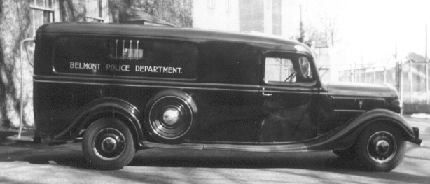
1935 Ford Wagon
Jerry Ryan died in 1917 and John Argy was appointed Chief. He had been a Constable since 1896 and night officer since 1899. A police horn and red flashing light signal system was installed throughout the town and "has proved most effective on many occasions in the apprehension of wrongdoers."
The final police officer shown in the picture (shown above) is David S. McCabe. Following his service as a Constable, he was appointed the towns first Building Inspector in 1899, and later elected Selectman in 1908 serving until his death in 1913. Thus all four men shown in the picture eventually became officials of the Town.
Upon Mr. Argy's death in 1928, John J. O'Brien was named Chief serving until his death in 1938. During his tenure, in 1931 the present day police station at the corner of Concord Avenue and Pleasant Street was constructed. For many years prior to that time the police department operated out of a room in the basement of the town hall complete with two jail cells. An article on the new station concluded with "Equipment for carrying on the work of the department has been added as necessary and now included a modern, well equipped ambulance and patrol car, two motorcycles, chief's car, and service car. The equipment also includes first aid boxes, riot guns, tear bombs and hand grenades for use in emergency work." They must have been preparing for World War II!
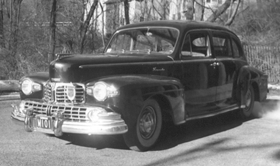
Police Chief William G. Heyd's Lincoln, 1946
The next Chief was William G. Heyd who had been a member of the force since 1925. He headed up the department for the next 24 years and for many Belmont "old-timers" probably the best known Police Chief.
Upon his retirement in 1962, Lt. Joseph J. Drolette filled the top job until Donald Robinson was appointed in 1963. He served for only five years retiring in 1968.
Alfred H. King was then named acting chief, but in 1969, upon topping the civil service exam, Jeremiah V. Kiley was appointed the new chief. Chief Kiley held that position until retiring in 1981. He was followed by Robert T. Shea who served until he retired in June of 1992.
Lt. Daniel P. Pergamo filled in as acting chief for about a year until the Selectmen appointed Chief Ronald J. Blanchette, who retired in 2002
Captain Andrew E. O'Malley Jr. was appointed acting chief in the fall of 2002, and appointed permanent chief in October 2003, Chief O'Malley retired in April of 2006.
Assistant Chief Richard Lane was appointed acting chief in May of 2006.
Arlington PD Captain Richard J. McLaughlin was appointed Chief in February of 2007, he is the first Chief to be appointed from outside the Department. Chief McLaughlin retired in December of 2019.
Assistant Chief James MacIsaac was appointed Police Chief in January of 2020.
So from David Chenery, Jr. to James MacIsaac, the town has been served by twelve Police Chiefs over a 143 year period.

1933 Buick Ambulance
From The Newsletter of the Belmont Historic Society, March 1998
Written by Richard Betts, Belmont Town Historian.

